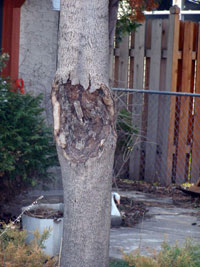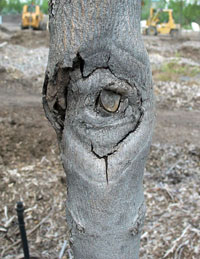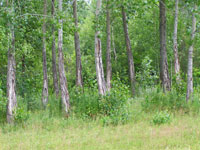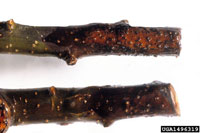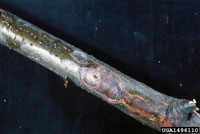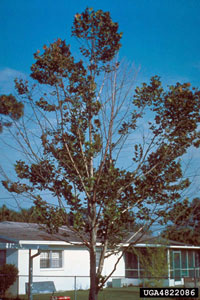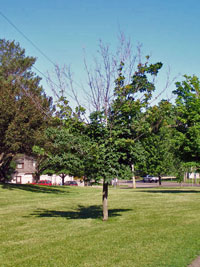Extension > Garden > Diagnose a problem > What's wrong with my plant? > Deciduous Trees > Maple > Sunken discolored areas along trunk/branches
Maple > Branches > Sunken discolored areas along trunk/branches
1 of 5
Eutypella canker
Eutypella parasitica
- Young cankers appear as round flattened, bark covered areas on main trunk or larger branch
- As cankers age, the flattened surface turns black and bark begins to fall off revealing decaying wood in a target shape pattern below
- Branch stub or other wound is often visible at center of the canker
- White to buff-colored fungal growth may be seen around outer portions of expanding canker if bark is removed
- Old cankers may develop a thick ring of wound wood surrounding the canker, making that area wider than the trunk above or below
- Occurs on all maples but common on sugar maples in forest settings and Norway maples in urban settings
- More information on Eutypella canker
2 of 5
Perennial nectria canker
Neonectria ditissima
- Sunken round to oval cankers with target shaped ridges of barkless wood on large branches or the main trunk
- Small dark sunken area on twigs that can girdle and kill the branch
- Red to reddish orange raised cushion like bumps can occasionally be seen on the edge of the canker
- More information on Perennial nectria canker
3 of 5
Frost crack
- Vertical splits or sunken dead areas of trunk or branches that are primarily on the south and southwest side
- Occurs during winter, often noticed early spring
- More information on Frost crack
4 of 5
Branch cankers
Botryosphaeria obtusa, Valsa spp. and other fungi
- Cankers are brown to black sunken areas on branch that may have cracked bark and discolored sapwood
- Random dead branches seen throughout canopy
- Leaves on random branches wilt, turn yellow then brown during the growing season
- Infected branches don’t leaf out in spring
- Common on trees stressed by drought, winter injury, wounds, insect feeding or other factors
- More information on canker
5 of 5
Coral spot canker
Nectria cinnabarina
- Sunken dark brown area on branch that is often cracked or has a ridge at the edge
- Raised cushion-like bumps on affected branches, may be cream to orange or red, turn black with age
- Dead branches and twigs, often first observed in early spring
- Common on trees stressed by drought, recent transplant or other factors
- More information on Coral spot canker



